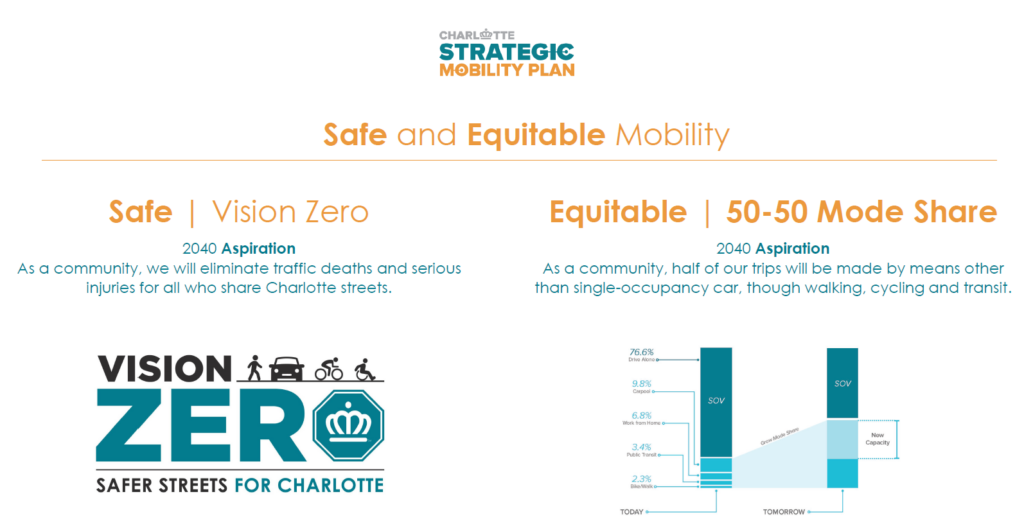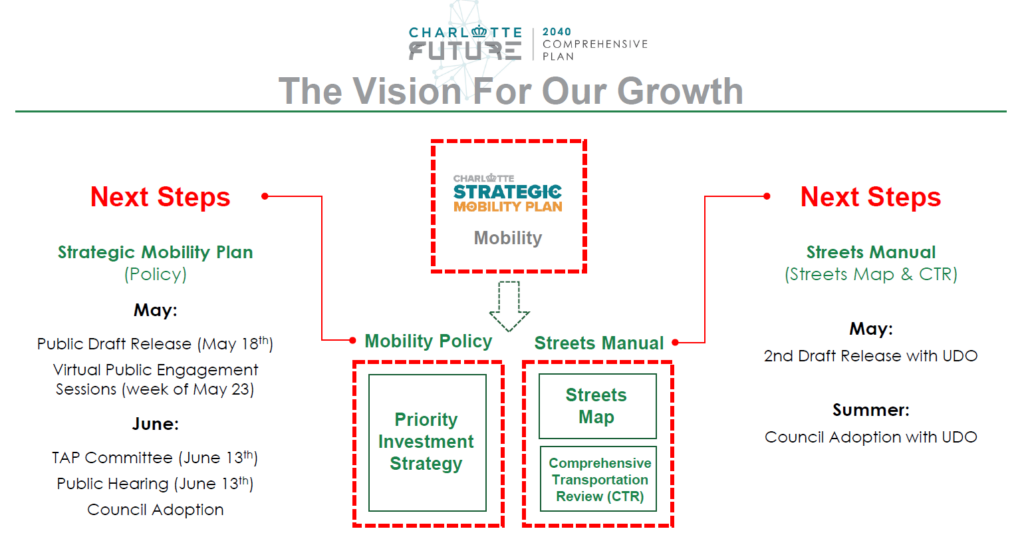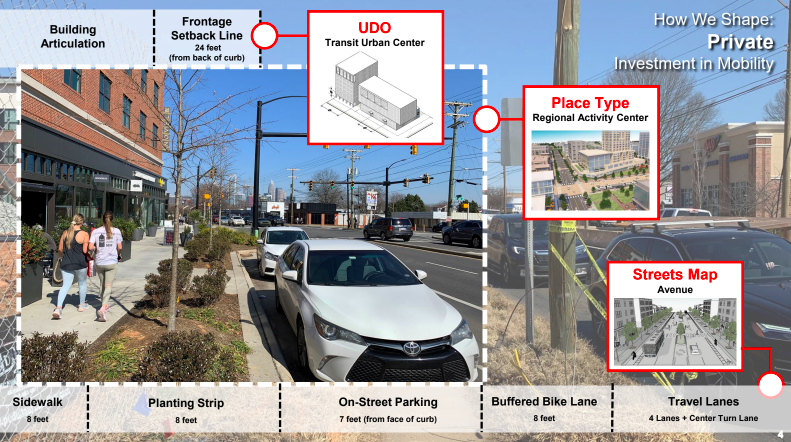City proposes 2040 goal of 50% sustainable trips!
During City Council’s Transportation & Planning Committee meeting on May 9th, Charlotte DOT staff informed the Committee members that the soon-to-be-released Strategic Mobility Plan will incorporate an ambitious mode share goal. By 2040, 50% of trips in our city should be completed in a way other than by single-occupancy car.
Sustain Charlotte is excited to see this newly released mode share goal that we’ve been advocating for since early 2020, and we’re fully supportive of this initiative to become a city where all people can travel safely and efficiently without the need for a car. This mode share goal will play an essential role in helping Charlotte reach its Strategic Energy Action Plan goal to become a low-carbon city by 2050.
On February 14th and again on March 14th, Ed McKinney from the City of Charlotte Department of Transportation (CDOT) presented the Transportation & Planning Committee with guidance on how the Strategic Mobility Plan (SMP) is going to be integrated into the planning process under the proposed Unified Development Ordinance (UDO) when both are expected to be put in front of the City Council for adoption this summer.
The Strategic Mobility Plan has been developed to address goal #5 of the Charlotte Future 2040 Comprehensive Plan: “Safe and Equitable Mobility”.

The SMP has two major components – the Mobility Policy and the Streets Manual, and together they feed into the UDO. The Streets Manual in turn is comprised of the Streets Map and the Comprehensive Transportation Review (CTR). The scheme below from the city’s website is a good illustration of the relationship between the above-mentioned plans.

The Streets Map is a critical element of the planning process because it will define street types in our city, such as parkways, avenues, boulevards, or main streets. The type of the street would define the width of the road space, how wide the sidewalk or planting strip would be built, and how much space would be allocated for the development of future buildings along the street.
The Streets Map gets overlaid with the 2040 Policy Map, which is the document that indicates what uses are acceptable for the piece of land adjacent to the street (for example, a multi-family apartment building or a commercial plaza). It is also overlaid with the UDO zoning district that provides all the nitty-gritty details on the construction guidelines (height, setbacks, and dimensional and design standards).
Below is an example of how all three elements are going to work together in the planning process. The Streets Map suggests that this type of street (an avenue in this case) is designed to have space for 2 travel lanes, and 8-foot wide buffered bike lane, 8 feet of planting strip, and 6-8 feet of sidewalk. The Place Type Map allocation suggests that this area should be Neighborhood 2 (residential). The UDO in turn provides more sophisticated guidelines about the building design (required setbacks, allowed height, etc).

Public/Private Investment in Mobility
The goal of the Strategic Mobility Plan is that it builds on the Charlotte Future 2040 Comprehensive Plan, refines the policies, and ensures that the priorities and investments we make as a city are fully in line with the vision we have for growth. The SMP is one of the tools the city uses to guide growth from a developmental standpoint.
The point of the Strategic Mobility Plan is that the city understands the “big picture” of growth, prioritizes where strategic connections need to be, and makes public investments accordingly. For example, when a CATS bus route is added or significantly changed, there is a number of steps that would need to be taken from the public investment perspective. For example: a signal priority study, investment in operations, and investments in infrastructure. In addition to public investments, there will be some expectations from the developers/private side as well.
Get Involved!
There are many ways to support the Strategic Mobility Plan, including the 50% mode share goal:
- SMP Virtual Engagement Sessions will be live on Thursday, May 26, at 6 p.m., and Tuesday, May 31, at 12 p.m. The meeting links are also available on the SMP homepage: charlottenc.gov/smp. Join the session that fits your schedule!
- Visit the SMP website (starting on the morning of Friday, May 20) to review and leave comments at your convenience.
- Additionally, sign up to share your input during the public comment period portion of the City Council Business Meeting on Monday, June 13, at 6 p.m
Thanks for reading!
As a nonprofit, community support is essential for us to keep doing what we do — including providing free articles like this. If you found this article helpful, please consider supporting Sustain Charlotte.
Want to stay in the loop? Subscribe to our weekly newsletter and follow us on Instagram, Facebook, and Twitter.
